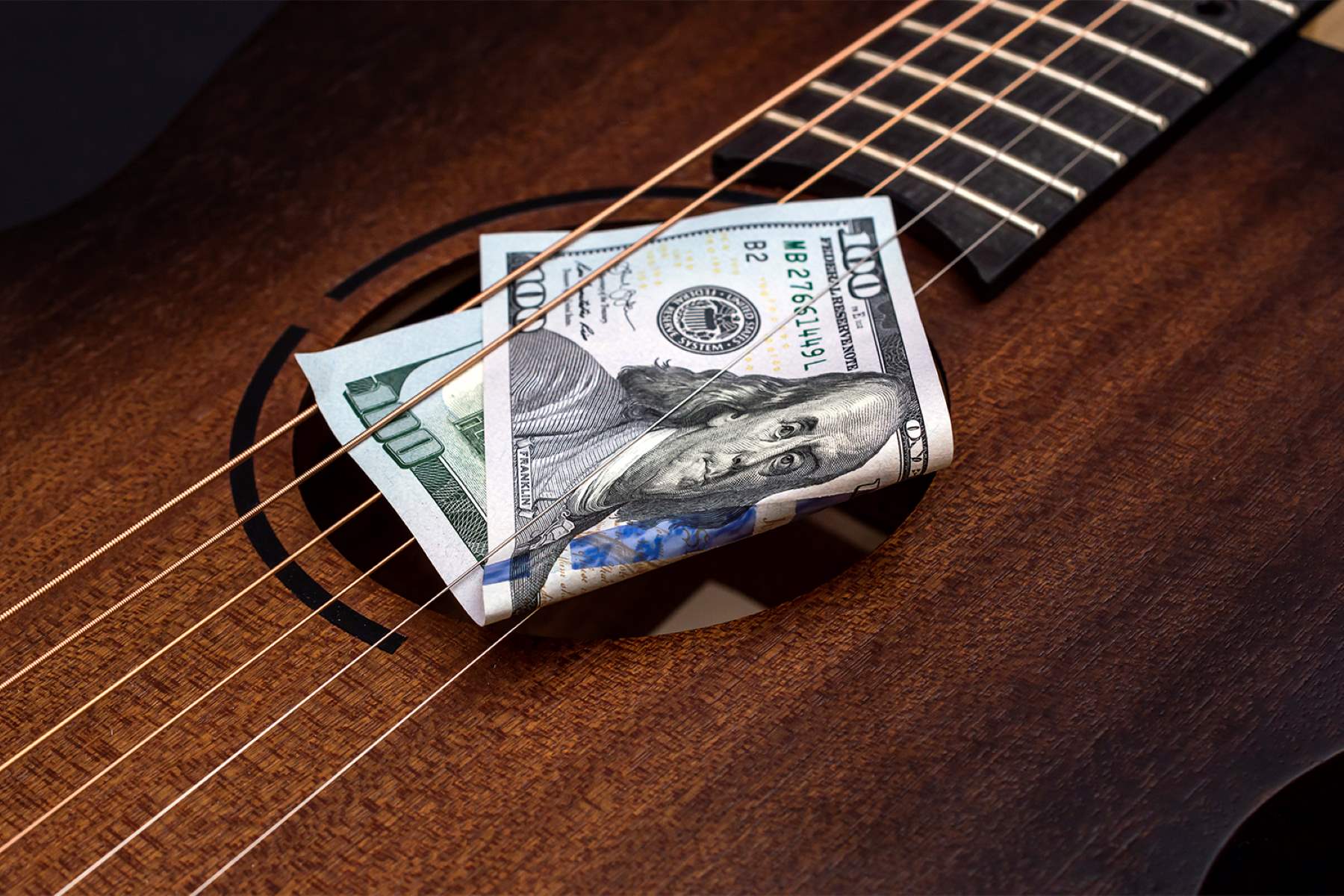Home>Production & Technology>Musician>How Much Does A Musician Make Per Stream


Musician
How Much Does A Musician Make Per Stream
Published: January 27, 2024
Discover how much a musician earns per stream and gain insight into the financial landscape for musicians in the digital age.
(Many of the links in this article redirect to a specific reviewed product. Your purchase of these products through affiliate links helps to generate commission for AudioLover.com, at no extra cost. Learn more)
Table of Contents
Introduction
Music streaming has revolutionized the way we consume music, providing easy access to millions of songs at our fingertips. For musicians, however, it has sparked a significant shift in how they earn a living from their art. The days of selling physical copies of albums and relying on radio play are gradually fading, making way for the dominance of streaming platforms.
While streaming offers unprecedented convenience for listeners, it has raised questions about how much musicians actually earn from each stream. The revenue model for streaming services is complex, with multiple factors influencing the amount that musicians receive.
In this article, we will delve into the world of music streaming revenue and explore the various factors that affect musician earnings. We will examine how streaming royalties work and provide insights into the average earnings that musicians can expect from each stream. Additionally, we will discuss the differences in payouts between streaming platforms and the impact that being an independent or major label artist can have on earnings. Furthermore, we will provide strategies for musicians to maximize their streaming revenue and offer a glimpse into the future of music streaming earnings.
By understanding the dynamics of the streaming industry and the factors that contribute to musician earnings, musicians can make informed decisions about their careers and embrace new opportunities in the ever-evolving music landscape.
Streaming Revenue Models
Streaming platforms operate on various revenue models, including freemium, ad-supported, and subscription-based services. Each model has its own implications for musician earnings.
Freemium platforms, such as Spotify, allow users to access music for free with occasional ads. Musicians earn revenue from a combination of advertising revenue and a fraction of a cent per stream. This revenue is typically lower than what is generated from premium listeners.
Ad-supported platforms, like YouTube, generate revenue from advertisements that play before, during, or after music videos. Musicians receive a portion of the ad revenue based on factors such as video views and engagement. However, the payout per stream tends to be lower than on subscription-based platforms.
Subscription-based platforms, such as Apple Music and Amazon Music Unlimited, charge users a monthly fee for unlimited access to their music library. Musicians earn a share of the subscription fee, which is distributed based on the number of streams their music receives. This model generally provides higher payouts per stream compared to freemium or ad-supported platforms.
It is worth noting that the revenue generated from these models is subject to deductions and fees, such as platform fees, distribution costs, and performance rights organization (PRO) fees. These deductions can vary, affecting the final amount that musicians receive.
Overall, the revenue models of streaming platforms directly impact the earnings of musicians, and understanding these models is crucial for musicians to navigate the streaming landscape effectively.
Factors Affecting Musician Earnings
Several factors play a role in determining how much musicians earn from streaming platforms. Understanding these factors can help musicians make informed decisions to maximize their revenue. Here are some key factors:
Number of Streams: The more streams a musician’s songs receive, the higher their potential earnings. Musicians with a large and dedicated fanbase will likely see higher earnings, as they accumulate a substantial number of streams.
Streaming Market Share: The market share of a streaming platform impacts musician earnings. Platforms with a larger user base, like Spotify and Apple Music, generally provide more opportunities for listeners to discover and stream music, resulting in higher earnings for musicians.
Geographic Location: Music consumption varies across different regions, resulting in differences in royalty rates. Musicians may earn more from streams in countries with higher streaming activity or with higher royalty rates.
Length of the Song: Streaming platforms pay artists based on the total playtime of their songs. Longer songs have the potential to generate higher earnings, as they accumulate more playtime per stream. However, shorter songs can still generate substantial revenue if they have a high number of streams.
Popularity and Discoverability: The popularity and discoverability of a musician’s songs can impact their earnings. Songs that receive frequent streams and are featured in playlists or recommendations are more likely to generate higher revenue.
Listener Demographics: The demographic profile of listeners who stream a musician’s songs can also influence earnings. Certain demographics may have a higher propensity to stream music and engage with artists, resulting in more streams and higher earnings.
Music Licensing Agreements: Musicians signed to major labels may have different licensing agreements compared to independent artists. These agreements can affect the percentage of revenue allocated to the musician and the distribution of royalties.
By considering these factors, musicians can strategize ways to increase their earnings from streaming platforms and adapt their promotional activities to target specific regions or demographics. It is crucial for musicians to stay informed and actively engage with their audience to boost their streaming revenue.
Understanding Streaming Royalties
Streaming royalties refer to the amount of money musicians earn for each stream of their songs on streaming platforms. It’s important for musicians to understand how these royalties are calculated to gain insight into their potential earnings. Here are some key aspects of streaming royalties:
Pro Rata Model: Many streaming platforms use a pro rata model to distribute royalties. This means that the total revenue generated by the platform is divided among all the streams during a specific period. Each stream is assigned a proportional share of the revenue, depending on the total number of streams on the platform.
Per-Stream Rate: The per-stream rate represents the average amount earned by a musician for each stream of their song. This rate can vary depending on factors such as the revenue generated by the platform, the number of streams, and the total number of songs streamed. While the per-stream rate is generally low, musicians with a significant number of streams can still generate substantial revenue.
Streaming Royalty Pools: Streaming platforms allocate a portion of their revenue to a streaming royalty pool, which is then distributed to musicians based on the number of streams their songs receive. The size of the pool can vary, impacting the final earnings for musicians.
Performance Rights Organizations (PROs): PROs play a significant role in collecting and distributing royalties to musicians. These organizations, such as ASCAP, BMI, and SESAC, ensure that musicians receive the royalties they are entitled to for their performance of songs on streaming platforms. PROs negotiate licensing agreements with streaming platforms and distribute the royalties collected to the respective artists.
Metadata Accuracy: Properly maintaining accurate metadata for songs is crucial for ensuring accurate royalty distribution. Metadata includes information such as song title, artist name, and album details. Inaccurate or missing metadata can lead to royalties being misallocated or not being properly tracked.
It’s worth noting that the specific calculation and distribution of streaming royalties can vary among different platforms and countries. Additionally, licensing agreements between streaming platforms and record labels may also impact how royalties are distributed.
By having a clear understanding of how streaming royalties are calculated, musicians can better evaluate their earnings and explore strategies to optimize their revenue streams. It’s important for musicians to stay informed about industry trends and changes in royalty distribution to effectively navigate the evolving landscape of music streaming.
Average Earnings per Stream
Calculating the exact average earnings per stream is challenging due to the various factors involved, including revenue models, streaming platform payouts, and individual musician agreements. However, it is possible to provide a rough estimate based on available data.
The average earnings per stream can range from a fraction of a cent to a few cents. On major streaming platforms like Spotify and Apple Music, the typical range is between $0.003 and $0.008 per stream. This means that for every 1,000 streams, a musician can expect to earn approximately $3 to $8.
It is important to note that these figures are rough estimates and can vary depending on the individual artist’s licensing agreement and the geographic location of the streams. Additionally, niche genres or less popular artists may have lower earnings per stream.
While the average earnings per stream may seem low, it is crucial to take into account the cumulative effect of multiple streams. Musicians who have a substantial number of streams can generate significant revenue over time. For example, a song with 1 million streams could potentially earn the artist around $3,000 to $8,000.
It’s also important to understand that streaming revenue is just one component of a musician’s overall income. Musicians can earn additional revenue through other sources such as live performances, merchandise sales, sync licensing, and crowdfunding.
To maximize earnings, musicians need to focus on growing their fanbase, actively promoting their music, and engaging with their audience. Strategies such as playlist placements, targeted marketing campaigns, and collaborations can help increase streams and ultimately boost earnings per stream.
It’s important for musicians to set realistic expectations and diversify their income streams to create a sustainable career in the music industry. While the average earnings per stream may not be substantial on their own, a combination of revenue sources can contribute to a musician’s overall success.
Variations in Streaming Platform Payouts
Streaming platforms differ in their payout structures, which directly impact the amount of revenue musicians earn from each stream. Here are some variations in streaming platform payouts to consider:
Premium vs. Freemium: Freemium platforms, where users can access music for free with occasional ads, generally have lower payout rates compared to premium platforms that require a subscription. Premium platforms typically generate higher revenue, resulting in higher payouts per stream for musicians.
Market Share and User Base: Streaming platforms with larger market shares and user bases, such as Spotify and Apple Music, generally offer better payouts due to higher streaming activity and revenue. These platforms have more subscribers and listeners, contributing to increased earnings for musicians.
Country-Specific Rates: Streaming platform payouts can vary based on the geographic location of listeners. Certain countries may have higher royalty rates, leading to increased earnings for musicians whose songs are frequently streamed in those regions.
Major Label vs. Independent Artists: Major label artists may have different licensing agreements and negotiating power, which can impact the percentage of revenue allocated to them. Independent artists, on the other hand, may have more control over their earnings but may face challenges in getting their music noticed.
Exclusive Releases and Deals: Streaming platforms sometimes secure exclusive releases or promotional deals with artists. These arrangements can involve higher payouts or special promotional efforts to increase streams. However, not all artists have access to such opportunities, and it’s important to weigh the potential long-term benefits against any exclusivity restrictions.
Listener Behavior and Engagement: The engagement level, listening habits, and preferences of users on different platforms can influence musician earnings. Some platforms may have more active and engaged user bases, resulting in higher streams and subsequently increased earnings for musicians.
Algorithmic vs. Curated Playlists: Streaming platforms utilize both algorithmic and curated playlists to recommend music to users. Being featured on popular playlists, especially curated ones, can lead to a significant increase in streams and revenue for musicians. However, the allocation of these placements is at the discretion of the platform and can vary widely.
Monetization of User-Generated Content: Some platforms, like YouTube, allow users to create and share content that includes copyrighted music. Musicians can earn revenue from advertisements shown on these videos. The platforms have specific policies and algorithms in place to identify and monetize user-generated content that includes their music.
It’s important for musicians to understand the variations in streaming platform payouts and consider these factors when choosing which platforms to prioritize. Diversifying their presence across multiple platforms can also help mitigate the impact of payout variations and maximize their overall streaming revenue.
Independent vs. Major Label Artists
The choice between being an independent artist or signing with a major record label has significant implications for musicians’ earnings and careers. Let’s explore the differences between independent and major label artists:
Control and Ownership: Independent artists have full control and ownership of their music. They have the freedom to make creative decisions and retain the rights to their work. Major label artists, on the other hand, often have to share creative control and ownership of their music with the label.
Financial Investment: Independent artists typically shoulder the financial responsibility of producing and promoting their music. They need to allocate their own resources for recording, marketing, and distribution. Major label artists benefit from the financial backing of the label, which covers the expenses associated with producing and promoting the music.
Visibility and Resources: Major label artists often have access to a larger promotional and distribution network. They can leverage the label’s existing industry connections, marketing strategies, and resources to increase their visibility. Independent artists, on the other hand, need to invest time and effort into building their own network and finding alternative ways to promote their music.
Royalty Split: Major label artists typically receive a smaller percentage of the revenue generated from their music streams or sales due to the various deductions and recoupable expenses outlined in the contract. Independent artists, however, have more control over their royalty split and usually retain a higher percentage of their earnings.
Payout Structure: Major label artists may benefit from upfront advances and higher payout rates per stream from streaming platforms. Independent artists tend to earn a lower per-stream rate but have the potential to earn more overall if they accumulate a significant number of streams.
Artistic Freedom: Independent artists have the freedom to experiment and explore their creativity without the pressure of meeting commercial expectations. They can pursue niche genres and develop a unique artistic identity. Major label artists might face more commercial pressures and expectations to produce mainstream and commercially successful music.
It’s important to note that there is no one-size-fits-all approach, and the choice between being an independent or major label artist depends on various factors, including artistic goals, financial resources, and personal preferences. Many successful musicians have found success both as independent artists and after signing with major labels.
Ultimately, both paths have their own advantages and challenges. Independent artists have the flexibility and ownership of their work, while major label artists can benefit from the label’s resources and industry connections. With the evolving music industry landscape, independent artists now have access to a wide range of tools and platforms that can help them reach a global audience and generate significant revenue.
It’s crucial for musicians to carefully consider their individual goals and circumstances and make an informed decision that aligns with their vision and long-term career objectives.
Strategies to Maximize Streaming Revenue
Maximizing streaming revenue requires a strategic approach that focuses on increasing streams, engaging with listeners, and optimizing the monetization potential of music. Here are some effective strategies to consider:
Create High-Quality and Engaging Music: Producing high-quality music that resonates with listeners is crucial for generating streams and building a dedicated fan base. Focus on creating compelling and unique music that stands out in the saturated streaming market.
Build a Strong Online Presence: Establish a strong online presence across various platforms, including streaming platforms, social media, and artist websites. Engage with fans, share updates regularly, and foster a sense of community among your listeners.
Promote Your Music through Playlists: Getting your music featured on popular playlists can significantly increase exposure and streams. Reach out to curators and submit your tracks for consideration. Additionally, consider creating your own playlists to showcase your music as well as songs from other artists in your genre to attract new listeners.
Collaborate with Other Artists: Collaborating with other artists can expand your reach and introduce your music to new audiences. Seek opportunities to collaborate on tracks, features, or joint projects to cross-promote each other’s music and attract new streams.
Engage with Your Fans: Interacting with your fans builds a loyal and supportive fan base. Respond to comments, messages, and emails promptly. Consider hosting live streams, Q&A sessions, or exclusive content for your fans to deepen the connection and encourage their ongoing support.
Utilize Social Media Advertising: Use targeted advertising on platforms like Facebook and Instagram to reach potential listeners who match your target audience. Customizing your ads based on demographics, interests, and location can help increase awareness and drive more streams.
Encourage Sharing and Playlist Adds: Encourage your fans to share your music with their friends and add your songs to their personal playlists. Word-of-mouth promotion and playlist additions can significantly increase your streams and visibility.
Collaborate with Influencers: Collaborating with social media influencers or content creators in your genre can expose your music to a wider audience. Seek influencers who align with your style and music and explore opportunities for sponsored content or features.
Explore Sync Licensing Opportunities: Sync licensing involves placing your music in TV shows, films, commercials, or video games. This can generate additional revenue and increase exposure for your music, potentially leading to more streams on streaming platforms.
Stay Active and Consistent: Consistency is key in building your streaming revenue. Regularly release new music, engage with your fans, and adapt your strategies based on analytics and feedback. Keep an eye on industry trends and be open to experimenting with new approaches.
Remember, maximizing streaming revenue takes time and effort. It’s important to stay patient, adapt to evolving trends, and continuously refine your strategies to make the most out of your music streaming journey.
The Future of Music Streaming Earnings
The future of music streaming earnings holds both opportunities and challenges for musicians. Here are some key trends and developments to consider:
Increased Adoption and Revenue Growth: Music streaming is expected to continue its upward trajectory as more listeners around the world embrace the convenience and accessibility of streaming platforms. This growth will likely result in increased revenue for musicians as the user base expands, leading to higher streams and potential earnings.
Emerging Markets and Global Reach: Streaming platforms are expanding into new markets, especially in developing countries with growing internet penetration. This expansion opens up opportunities for musicians to reach a global audience, potentially increasing their streams and revenue.
Personalized Recommendations and Algorithms: Streaming platforms are investing in advanced algorithms and data analytics to deliver personalized music recommendations to listeners. This presents an opportunity for musicians to have their music discovered by new audiences based on their listening preferences, potentially increasing streams and revenue.
Direct-to-Fan Monetization: Independent artists now have access to various tools and platforms that enable direct-to-fan monetization. This includes platforms for fan subscriptions, merchandise sales, virtual concerts, and crowdfunding. These avenues allow musicians to diversify their revenue streams and build a closer connection with their fans.
Blockchain and Decentralized Platforms: Blockchain technology is gradually being adopted in the music industry, offering potential solutions for transparency, royalty distribution, and fair compensation. Decentralized platforms are emerging, aiming to give artists more control over their music and enable direct peer-to-peer transactions, potentially leading to higher earnings for musicians.
Podcasts and Audio Content: The rise of podcasts and other audio content presents new opportunities for musicians to expand their reach and engage with listeners. Musicians can create and monetize their own podcasts, collaborate with podcasters, or have their music featured in podcast episodes, helping to increase exposure and potential earnings.
New Revenue Models and Agreements: The music industry continues to evolve, and new revenue models and agreements are being explored. For example, platforms are experimenting with higher artist payouts, fan tipping features, and user-centric payment models that allocate revenue based on an individual user’s listening habits. These innovations aim to create fairer compensation for artists and potentially increase streaming revenue.
It’s worth noting that the future of music streaming earnings is constantly evolving, and it’s essential for musicians to stay informed, adapt to changing trends, and leverage emerging opportunities to maximize their revenue. Building a strong online presence, engaging with fans, and diversifying income sources will remain critical in navigating the evolving landscape of music streaming.
Conclusion
The world of music streaming offers both opportunities and challenges for musicians. While the average earnings per stream may seem small, the cumulative effect of multiple streams can lead to significant revenue over time. Understanding the factors that affect musician earnings, such as streaming revenue models, licensing agreements, and listener behavior, is essential for maximizing streaming revenue.
Independent artists have the freedom to retain control over their music and potentially earn a higher percentage of revenue. Major label artists, however, benefit from the label’s resources and industry connections, which can increase their visibility and earning potential. Both paths have their own advantages and challenges, and musicians should carefully consider their goals and circumstances when choosing between independence and signing with a major label.
To maximize streaming revenue, musicians should employ strategies such as creating high-quality music, engaging with their fans, promoting their music through playlists, and collaborating with other artists. Building a strong online presence, leveraging social media advertising, and exploring sync licensing opportunities can also contribute to increased streams and earnings.
The future of music streaming earnings holds promise with increased market adoption, emerging technologies like blockchain, and the growth of personalized recommendations. Musicians can tap into these advancements to expand their global reach, explore new revenue models, and build direct connections with their fan base.
In conclusion, while the landscape of music streaming earnings may present challenges, it also offers countless opportunities for musicians to thrive. By staying informed, adapting to industry trends, and implementing effective strategies, musicians can navigate the streaming landscape and maximize their potential for sustainable and successful careers in the digital age of music.











